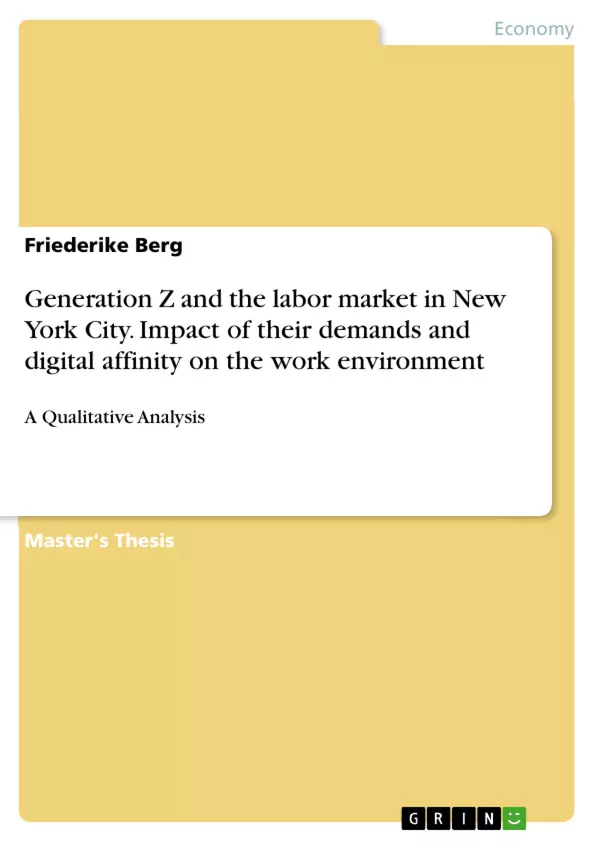The main objective of this study is to examine whether Gen Z’s demands will impact the labor market in NYC. Further, if it does, how will Generation Z impact the way this economy functions. The study also examines which industries and how they would be affected.
The study examines how Gen Z’s demands impact the future of NYC’s labor market. It will define development of NYC’s economy based on Gen Z’s digital affinity on the work environment, developments in regards to the work flexibility, and developments that appear due to the Zers’ entrepreneurial spirit. The trends will subsequently affect New York City’s work environment of today, the structure of the industrial cluster, and the structure, which is shaped by industry giants, of how we operate today.
Generation Z is entering New York City’s workforce and is about to substitute the Baby Boomer Generation. New York City’s labor market is not prepared for this change. It is the first generation that has grown up with the constant presence of the internet and the rise of social media, which makes it unique in comparison to other generations in the workforce. This study will identify the impact of Generation Z’s work expectations on New York City’s economy by conducting mixed methods with in-depth interviews with Zers that live in New York City. It focuses on the areas of digital affinity, work flexibility, and the entrepreneurial spirit. It is expected that New York City will faces enormous and not, in the short-term, solvable challenges.
Inhaltsverzeichnis (Table of Contents)
- Abstract
- Introduction
- Background
- Problem Statement
- Purpose Statement
- Research Question and Objective
- Hypothesis
- Definition of Terms
- Ethical Consideration
- Delimitations
- Limitations
- Significance of the Study
- Literature Review
- Generation Z
- Work Values
- Workplace and Work Environment
- Futuristic Vision for the Work
- History of Work
- Current Workforce
- Developments in the Labor Market
- Research Design and Methodologies
- Research Worldview
- Research Design
- Research Strategy
- Method of Data Collection
- Method of Data Analysis
- Population
- Sample
- Data Collection
- References
- Appendix
Zielsetzung und Themenschwerpunkte (Objectives and Key Themes)
This thesis aims to explore the impact of Generation Z's demands on New York City's labor market. The study will examine the unique characteristics of Gen Z, including their digital affinity, work flexibility preferences, and entrepreneurial spirit. The research will seek to understand how these characteristics will influence the future of the workforce in New York City.
- The impact of Generation Z's digital affinity on the workforce.
- The role of work flexibility in attracting and retaining Gen Z employees.
- The influence of Gen Z's entrepreneurial spirit on the economy.
- The challenges and opportunities faced by New York City's labor market in adapting to Gen Z's demands.
- The potential long-term impact of Gen Z on the workforce and economy.
Zusammenfassung der Kapitel (Chapter Summaries)
The introduction provides background information on Generation Z, highlighting their unique characteristics shaped by the digital age. It outlines the problem statement, focusing on the uncertainties surrounding the impact of Gen Z's digital presence on the workforce. The chapter then defines the research question, objective, and hypothesis, setting the stage for the study's inquiry.
The literature review delves into existing knowledge on Generation Z, exploring their work values, preferences for workplace environments, and visions for the future of work. It also examines the history of work, the current workforce, and developments in the labor market, providing context for understanding the challenges and opportunities presented by Gen Z.
The research design and methodologies chapter details the research approach, including the worldview, strategy, data collection methods, and analysis techniques employed in the study. It also defines the target population and sample, outlining the specific data collection processes used.
Schlüsselwörter (Keywords)
This study focuses on the impact of Generation Z's characteristics, particularly their digital affinity, work flexibility preferences, and entrepreneurial spirit, on New York City's labor market. The key terms include Generation Z, digital affinity, work flexibility, entrepreneurial spirit, labor market, and New York City economy.
- Citation du texte
- Friederike Berg (Auteur), 2020, Generation Z and the labor market in New York City. Impact of their demands and digital affinity on the work environment, Munich, GRIN Verlag, https://www.grin.com/document/541043



